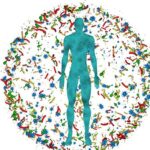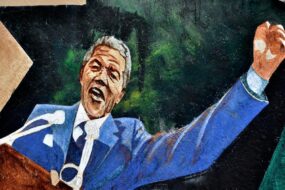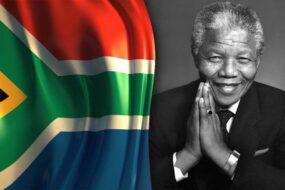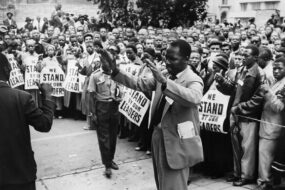“Project Coast: The Sinister South African Government Experiment That Shook the Nation”
What if you discovered a secret so perilous, even speaking about it coudl land you in prison? In the depths of apartheid-era South Africa, a clandestine government project was underway, shrouded in mystery and deceit. Project Coast, a covert military experiment, would push the boundaries of human endurance, ethics, and morality, leaving a trail of devastation and questions that would haunt the nation for decades to come.
It’s 1985 in Pretoria, and behind locked gates, government scientists, under the watchful eye of the apartheid regime, were testing something the world wasn’t ready for. The project, led by the infamous Dr. Wouter Basson, a chemist and microbiologist, aimed to develop a range of chemical and biological agents, including deadly toxins and incapacitating gases, designed to be used against anti-apartheid activists, dissidents, and even foreign enemies.The apartheid government, desperate to maintain its grip on power, saw Project Coast as a means to crush opposition and eliminate perceived threats to its authority.
As the project progressed, the scope of its ambitions grew more sinister. Scientists began experimenting with an array of toxic substances, including a highly potent and lethal agent known as cyclonite, which could kill within minutes of exposure. They also developed an incapacitating gas, designed to render targets helpless and disoriented, perfect for covert operations. The researchers worked tirelessly, often under the cover of darkness, to perfect their deadly craft, fueled by a zealot’s fervor and a disregard for human life.
The project’s architects were resolute in their determination to create an arsenal of terror, convinced that the ends justified the means. They recruited unwitting test subjects, often unsuspecting civilians, or prisoners, lured with promises of better living conditions or money. These individuals were subjected to inhumane experiments, forced to endure agonizing physical and psychological ordeals, without their consent or knowledge of the true nature of the project. The apartheid regime’s obsession with control and domination had created a monster, devoid of empathy or remorse.
As Project Coast gained momentum,the stakes grew higher,and the consequences more dire. The project attracted international attention, with whispers of its existence spreading like wildfire through diplomatic channels and activist networks. The apartheid government, however, remained resolute, convinced that its survival depended on the success of this clandestine endeavor. The project became a hydra-like entity, adaptable and resilient, with tendrils of deceit snaking through every level of government and security apparatus.
One of the most shocking aspects of Project Coast was its extensive use of assassination techniques, honed to perfection by the apartheid regime’s hitmen. Targets were identified, tracked, and neutralized, often using a tactic known as “operational removal,” a euphemism for extrajudicial killings. These covert ops left a trail of bodies, each one a testament to the regime’s willingness to eliminate anyone who dared challenge its authority. The hitmen, shrouded in mystery, moved with impunity, their actions concealed behind a veil of secrecy and intimidation.
The fall of apartheid in the early 1990s brought an end to Project Coast, but the truth about its atrocities would only begin to surface years later.In 1995, a Truth and Reconciliation Commission (TRC) was established to investigate human rights abuses during the apartheid era. The TRC’s findings on Project Coast were nothing short of damning, revealing a pattern of reckless disregard for human life and a callous willingness to experiment on the vulnerable. Dr. Wouter Basson,the project’s ringleader,was eventually arrested and charged with crimes against humanity,but his conviction was later overturned on appeal.
The legacy of Project Coast continues to haunt South Africa, a constant reminder of the darkest aspects of its troubled past. The country’s ongoing struggle to confront its demons, to reconcile with its victims, and to rebuild its shattered society, serves as a testament to the enduring impact of this sinister experiment. As the nation slowly comes to terms with its complicated history, the story of Project Coast serves as a chilling cautionary tale, highlighting the perils of unchecked power, scientific hubris, and the dehumanizing effects of oppression.
The story of Project Coast is a sobering reminder of the darker aspects of human nature, a testament to the destructive power of fear, paranoia, and ambition. As we reflect on this dark chapter in south African history, we are forced to confront uncomfortable questions about our own capacity for cruelty, our willingness to sacrifice the vulnerable, and our tendency to justify the unjustifiable. The shadows of Project Coast will continue to haunt us,a grim reminder of the devastating consequences of allowing our worst impulses to guide us.#ProjectCoast #SouthAfricanSecrets #ApartheidEra #ChemicalAndBiologicalWarfare #GovernmentExperiments #SinisterScience #TruthAndReconciliation #DarkHistory #SouthAfricanHistory #InfographicStory #truestory #DidYouKnow #HistoryNerd #GlobalFigures #AfricanHistory #UnsettlingTales #ExperimentalScience #toxiclegacy #UnravelingTheTruth
<img class="bimage_class" src="https://campusstore.co.za/wp-content/uploads/2025/04/andela.jpgbb39.jpg" alt="The Unyielding Spirit of Nelson Mandela: A Story of triumph Over Apartheid
Imagine being imprisoned for 27 long years, yet emerging not as a bitter or broken man, but as a beacon of hope and reconciliation for an entire nation. What kind of person can endure such hardship and still manage to forgive their captors? Nelson Mandela,the legendary anti-apartheid revolutionary and former President of South Africa,is one such extraordinary individual whose life story is a testament to the power of resilience,compassion,and the human spirit.
In the early 20th century, South Africa was a country torn apart by the brutal system of apartheid, a complex web of laws and social norms that institutionalized racial segregation and disenfranchisement.The white minority government, dominated by Afrikaners, held sway over the black majority, imposing harsh restrictions on their lives, from were they could live and work to whom they could marry. The black population was subjected to forced labor, poverty, and violence, sparking a growing resistance movement that would eventually give rise to leaders like Nelson Mandela.
Born on July 18, 1918, in the small village of Mvezo, Mandela was raised in a traditional Thembu family. He was the son of a local chief and was exposed to the values of leadership and community service from a young age. As he grew older, Mandela became increasingly aware of the injustices of apartheid and the struggles of his people. He was drawn to the African National Congress (ANC), a liberation movement that sought to challenge the apartheid regime through nonviolent means. However, as the government’s brutality intensified, Mandela and his fellow activists began to question the effectiveness of peaceful protest.
The turning point came in 1960, when police fired on a peaceful protest in the town of Sharpeville, killing 69 unarmed black people. The event shocked the world and marked a turning point in the anti-apartheid movement.Mandela, who had by then become a key leader in the ANC, realized that armed resistance was necessary to challenge the regime. He co-founded the ANC’s armed wing, Umkhonto we Sizwe (Spear of the Nation), and was subsequently arrested and put on trial for treason in 1962. The trial, which lasted from 1963 to 1964, was a highly publicized event that drew international attention to the anti-apartheid cause.
Mandela’s famous “I Am Prepared to Die” speech, delivered in court on April 20, 1962, became a rallying cry for the movement. In it, he declared his willingness to sacrifice his life for the cause of freedom and equality. The speech, which was widely reported in the media, galvanized international opinion against apartheid and put pressure on the South African government to justify its actions. Although Mandela was ultimately sentenced to life imprisonment, his words had ignited a fire that would burn brightly for decades to come.
The years that followed were marked by Mandela’s harsh treatment at the hands of the authorities.He was sent to Robben island, a remote prison island off the coast of Cape Town, where he was subjected to hard labor, isolation, and mistreatment. Despite the harsh conditions, Mandela remained defiant, using his time in prison to read, reflect, and engage in secret negotiations with his jailers. He became a symbol of resistance, not just for South Africans but for people around the world who were fighting against oppression and injustice.
As the years turned into decades, the apartheid regime began to crumble under the weight of internal resistance, economic sanctions, and international pressure. In the late 1980s, the government, led by President F.W. de Klerk,began to implement reforms,releasing some political prisoners and easing restrictions on anti-apartheid organizations. Mandela, now an international icon, was finally released from prison on February 11, 1990, after 27 long years behind bars. The event was met with jubilation around the world, as people hailed Mandela as a hero and a symbol of hope.
The years that followed were marked by a delicate dance between Mandela and the government,as they negotiated a transition to democracy. In 1994, South Africa held its first multiracial democratic elections, and Mandela, as the ANC’s candidate, became the country’s first black President. His inauguration was a momentous occasion,attended by dignitaries from around the world. As President, Mandela worked tirelessly to heal the wounds of apartheid, establishing the Truth and Reconciliation Commission to investigate human rights abuses and promote national reconciliation.One of the most remarkable aspects of Mandela’s story is his capacity for forgiveness. despite being subjected to decades of imprisonment and mistreatment,he chose not to seek revenge or retribution against his former captors. Instead, he worked to bring the country together, using his moral authority to promote healing and understanding. His leadership was not without its challenges, though. He faced opposition from within his own party, as well as from conservative white groups who resented the changes he was bringing about.
As Mandela’s presidency came to an end in 1999, he left behind a legacy that continues to inspire people around the world. He had played a crucial role in ending apartheid and had helped to bring about a new era of democracy and reconciliation in South Africa. His story is a testament to the power of courage, compassion, and perseverance in the face of overwhelming adversity.
Today, Nelson Mandela’s memory lives on, not just in South Africa but around the world. He remains an icon of hope and freedom, a reminder that even in the darkest of times, there is always the possibility for change and redemption. As we reflect on his remarkable life, we are reminded of the enduring power of the human spirit to overcome even the most daunting challenges.
#infographicstory #worldhistory #NelsonMandela #Apartheid #SouthAfrica #HistoryNerd #TrueStory #GlobalFigures #Reconciliation #Forgiveness #Leadership #Democracy #FreedomFighter #AntiApartheidMovement #MandelaLegacy”>










